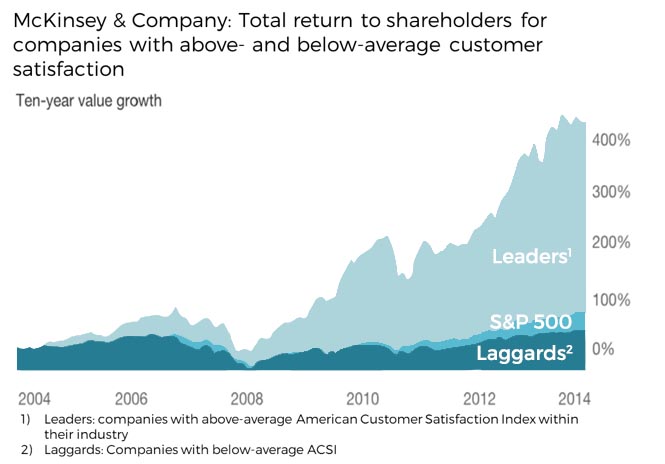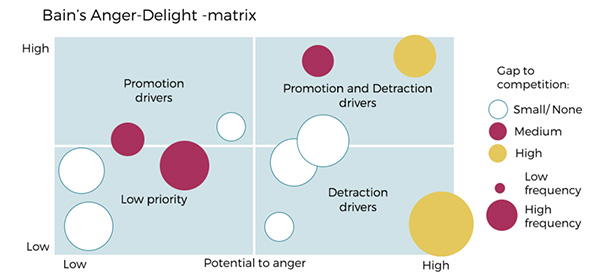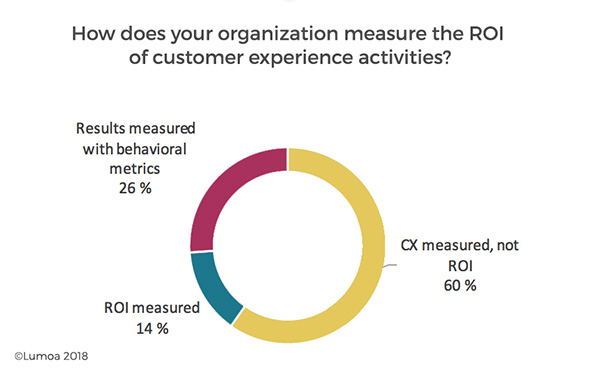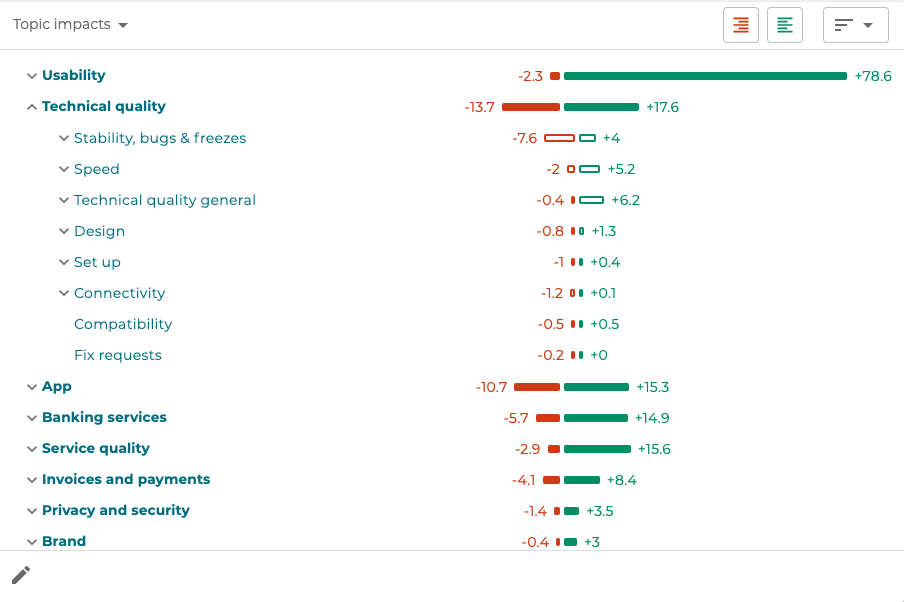Business Value and ROI of Customer Experience: The Step-by-step Guide

Last updated on September 27, 2022
Is it possible to determine the ROI of customer experience, if so, how do you do that? In this article, we explain the relationship between revenue growth and customer experience. In addition, we share tools that will help you calculate the ROI of your own customer experience projects.
Most business leaders believe that customer experience will be the key driver of their company’s competitiveness going forward. However, when it comes to actual customer experience management, things get difficult.
It is not too difficult to listen to the customer. Companies receive real-time feedback in massive volumes if they only start listening to their customers. Insightful analytics is possible with modern technologies such as Lumoa that have machine-learning-based text analytics.
Most organizations, that receive large amounts of customer feedback data, can buy text analytics solutions that help in making sense of the data and transform the chaotic customer voice data into structured info. As a leader, you often know what your customers think about your products and services, and where are the key improvement areas.
And yet still, acting on the customer feedback is hard.
For many companies, it is the hardest part of the whole customer experience management process.
Sometimes this is because of a lack of ownership in the company – when an issue exists because it falls between organizational silos, improving the customer experience requires some extra effort. However, in many cases, organizational silos are not the only reason for not acting on customer feedback.
The hardest challenge to overcome is often the money – or rather the lack of it.
Let’s face it: customer experience improvements require money. Not always, but often. And deciding to spend money on improving the customer experience is not easy if the financial benefits are not well understood. Customer experience-related decisions are no different from any other business decisions: you need a positive business case to justify them.
And yet, these decisions are extremely difficult to make because the outcomes can be very uncertain.
The people driving customer experience improvements are not always able to quantify the improvements in monetary terms (determining the ROI of customer experience). Our customer satisfaction increases – so what? Does it increase our revenue or profit? Will it positively impact our market share?
If you improve the availability of customer support agents, you certainly know how much it is going to cost. But will it improve the customer experience in a way that also has a positive impact on our business?
As a business leader, you are extremely familiar with numeric metrics – most likely your targets are around revenue growth and profitability. Customer experience is a different animal: it is somewhat unpredictable because it deals not only with what you do but also with how people perceive it. Emotions influence it.
There is a lag: even if your customer satisfaction drastically reduces after you have made some cuts to the customer service headcount, it can take months before your customers have found a new vendor and can leave you for your competitor.
There is a lot of research and studies about the relationship between financial metrics and customer experience metrics. I will first outline what is generally known. But are the general results applicable to your company? Not necessarily. Later I will go through how you can understand step-by-step what the value and ROI of customer experience are for your company.
So let’s get started.
The financial benefit of improving the customer experience
Improved customer experience drives revenue growth
Multiple studies have shown that revenue growth is impacted by customer experience. Forrester’s report “Customer Experience Drives Revenue Growth” showed that customer experience leaders achieved compound average revenue growth of 17% over five years. The CX laggards achieved just 3% growth during the same period.
Bain & Company’s analysis in 2015 showed that customer experience leaders grow revenues 4% – 8% above their market. Bain & Company’s analysis concluded that the revenue impact of improving customer experience is because the superior experience helps to earn stronger loyalty among customers, turning them into promoters who tend to buy more, stay longer and make recommendations to their friends.
The strongest impact results from improved loyalty
The revenue growth is primarily generated by the impact that a good customer experience has on improving customer loyalty. Loyal customers are valuable. According to Customer Experience statistics, it can be five times more expensive to find a new customer than to keep a current one. The probability of selling to a new prospect is 5-20%, while the probability of selling to an existing customer is 60-70% according to Marketing Metrics.
Murphy & Murphy estimate that a 2% increase in customer retention has the same effect on profits as cutting the costs by 10%. Therefore, for many companies, improved customer retention often provides the most obvious rationale for making customer experience improvements.
McKinsey research in the US showed that enhancing the customer experience can bring significant financial benefits: “Across industries, satisfied customers spend more and stay more loyal over time. In banking, customers are seven times more likely to increase their deposits and twice as likely to open an additional account if they rate a bank as excellent rather than average. Similarly, pay-TV customers who rate their provider as excellent tend to stay with it for up to twice as long as they would a provider they rate as average or below.”
The customer experience and retention are clearly linked but the strength of the link does have some industry-specific differences. Industries and companies with low switching barriers see a bigger positive impact from customer experience investment. If the switching barriers are high, the customer experience investments don’t necessarily pay off.
Because of the different switching barriers, customer experience investments typically lead to the highest return on investment in industries such as hospitality, retail, and consumer products. In industries such as utilities, health care, and banks, the linkage is weaker because of the higher switching costs.
Typically, in these industries, a bad customer experience can have a negative impact on revenue, but it is difficult to generate a positive impact. People leave your business if you manage to upset them, but they are not leaving a vendor whose customer experience is on an acceptable level even if you provide something better.
It does pay off in the long term
The impact on loyalty and therefore revenues seems to be clear, but does it matter for the shareholders? What is the long-term impact of a good customer experience? The long-term impact of a good customer experience is certainly more difficult to prove.
However, as the following picture shows, the shareholder return of good customer experience seems to be significant. The total return to shareholders of companies with above-average customer satisfaction was four times higher than the total return to shareholders of the below-average companies over a then ten-year period.

It was claimed that a significant change in customer satisfaction levels typically hits a company’s earnings after three to eleven months. The window is long and there are certainly industry-specific differences depending on how easy and fast it is to switch providers. But what is clear, is that seeing financial benefits from customer experience investments does require some patience.
But the linkage to market share is somewhat complex.
When you choose to invest in improving the customer experience and gain loyal customers as a reward, your competitiveness improves, and so does the ROI of customer experience. This should increase your market share, given that all the other variables stay constant (e.g. that your competitors don’t do similar moves at the same time). However, looking at how customer experience and market share correlate, the relationship is more complex than this.
While the improved customer experience normally leads to a higher market share, the market leaders typically don’t have the highest customer satisfaction.
On the contrary: typically, niche players who can target their offering to a very specific audience, have the happiest customers.
The biggest players serve a very heterogeneous group of customers and the customer experience tends to be average because they must serve a diverse group of people with diverse needs.
Because of this phenomenon, for some companies a decreasing market share can lead to increased customer satisfaction: when the unhappy customers leave the company and only the most loyal ones remain, the customer satisfaction metrics can start to show a positive trend. This is not something to be proud of.
So keep in mind that while customer experience and market share are linked, the correlation is not straightforward.
More money spent on customer experience is not always better
As the research shows, investment in the customer experience does make sense. It pays off to be a perceived customer experience leader also in the long run. However, when you are deciding on whether to invest in that particular training, add headcount or build a new easier-to-use payment system in your online store, you are not really dealing with customer experience-related investments in general, but one business case in particular.
Recommended reading:
How to justify a CX program to your CEO
Research conducted by Avanade and Sitecore showed that there is a $3 return on investment (ROI) expected for every $1 invested in the customer experience. However, this result was based on a survey with a target group of decision-makers responsible for digital experiences in large corporations. One could argue that in the area of digital experiences, both the need for transformation and the reward for successful investments, has been bigger than average.
More general research, however, highlights the asymmetric nature of customer experience spending. Failing to meet customer expectations can have significant negative consequences. Customer retention and repurchase intentions are negatively impacted by bad experiences.
However, delighting customers more than expected doesn’t necessarily pay off. It has been shown that failing to meet customer expectations has twice the negative impact as delighting customers has a positive impact. KPMG sums up the research results: “Delighting your customers reaches a point of diminishing returns quickly.”
KPMG divides the customer experience drivers into three different buckets: must-haves, selectors, and delighters. The must-haves are the basics that any organization must get right. The selectors are the drivers that can compel a customer from one competitor to another. And finally, the delighters are factors that surprise the customer positively. However, they only are impactful when the basics are in place. And, unfortunately, their impact erodes over time as customer expectations are reset.
Bain has illustrated this dynamic between various factors in a powerful way with the anger-delight matrix. The matrix reminds us how some drivers only have the potential to drive detraction (these are the basics or hygiene factors). You will lose customers if these don’t work.
Some drivers have the potential to drive promotion. These delight your customers when they are there, but the lack of them doesn’t typically drive detraction. And finally, there are drivers which can drive both promotion and detraction. Bain correctly highlights that your gap to the competition should help you in determining, which issues to tackle first.

How do you know which factors belong to which buckets? Is the list of hygiene factors always the same?
Ask your customers!
When you ask your customers to provide you with NPS feedback, it is the why-comments that will reveal the drivers. You’ll soon notice which topics drive only promotion, which drive detraction, and which drive both.
If your application crashes constantly, you are going to see it in the drivers of detraction. But most likely the stability of your application never appears in the promoter comments (unless you have a history of buggy apps).
Similarly, if your customer service personnel were not only professional and fast but also funny, caring, and showing empathy, you might see this in promoter comments. But the detractors most likely won’t list lack of funniness as a key reason for detraction. As Maurice Fitzgerald points out, the results of CSAT and NPS surveys are likely to point out both kinds of factors, while the Customer Effort Score typically captures detraction drivers.
Still, only partially convinced?
Don’t just trust what the industry benchmarks say but test the linkage yourself with your own data.
Now let’s find out how you can do that for your own company.
How do you estimate the ROI of Customer Experience?
When it comes to customer feedback, the most critical part of managing it is to make decisions and act based on it.
Collecting feedback and understanding what customers think has no intrinsic value. To be able to act, you need to understand how your actions influence the customer experience.
When you know what drives customer experience and by how much, you know how to improve it.
But before you can decide or choose between potential actions all competing for the same budget, you should obviously also understand, whether the customer experience improvement makes sense financially or not.
If you invest 100k€ to retrain your salespeople and get a 5-point NPS increase as a result, what then? Was it worth it? To understand this, you need to understand how the customer experience translates to customer behavioral changes, which have an impact on your financial metrics.
To understand the relationship between your customer experience and your financial metrics, think about the drivers of your business metrics according to the following picture.

1) Measure the customer experience to understand how your customers feel about you. This is the critical starting point, because the real-time measurement of customer experience with a metric such as NPS, provides you with the leading indicator through which you link the value to any actions you make.
2) Build a basic understanding of how, in your company, an increase in the customer experience metric impacts some critical customer behavioral metrics, e.g. when your NPS increases by 10ppt, your churn decreases by 1ppt. A tool like Lumoa shows you directly what and how much certain topics impact your customer experience metric negatively.
To do this, build hypotheses. Most likely you’ll find that retention (reduction of churn) is the key contributor. But you can also think of how better customer experience leads to upsell opportunities, more recommendations, fewer complaints, and product support cases. When you have listed the hypotheses, test.
3)Calculate how the change in behavioral metric impacts the financials, e.g. when the churn reduces by 1 point, the revenue increases by 2M€.
If you would like to get some concrete ideas on how to calculate this link, take a look at our ROI model for customer experience improvement. It is a simple excel tool for assessing the return on investment for your customer experience management activities.
When you know the financial value of the customer experience improvement, deciding on improvement actions to make should become easier. You should also be able to make these decisions as part of your normal decision-making process.
4)Understand what drives the customer experience metric and by how much, e.g. the unclear pricing drives the NPS down by 5 points.
5)How much does fixing this issue cost? What is the benefit? Make a cost-benefit calculation.
Do you want to get more insights into how to best to do this? We have put together a workbook outlining some concrete ways you can proceed through each of these steps.
If this sounds like a complex process, I have good news for you. If you do the groundwork properly once and establish a link between your NPS and financial metrics with one study, you don’t need to struggle with the business case work every time you suggest something new driven by the customer experience. If you know-how in your company the NPS and revenue correlate in general, and your daily work can move to make improvement actions based on the feedback you receive.
Understanding the ROI of customer experience is difficult
Surprisingly few companies understand the ROI of customer experience activities. We surveyed customer experience leaders in Nordics, and the results were somewhat staggering: only 14% of the companies responding to the survey were measuring the ROI of customer experience activities.
In most companies, customer experience was measured (the majority of companies are using NPS for that) but there was no systematic way to link this to financial results. In 26% of companies, the results were assessed using behavioral metrics, e.g. churn reduction. This is already a great start because it should provide a direct linkage to a monetary value.

Note that measuring the success of your customer experience improvement activities by measuring the customer experience itself is not wrong! It really is a good thing if your customers are happy! But as the lack of budget is a significant issue in most customer experience organizations and the decisions are difficult to make, it won’t hurt to be able to justify changes also in monetary terms.
If you still find it impossible to prove the monetary value of customer experience improvements, what should you do? It is possible that you cannot prove the linkage in your company because e.g. the lack of historical data.
Maybe you are only starting to collect customer feedback now. Because of that, you have no way of comparing how differently your promoters and detractors behave.
You might also experience other data-related challenges. Maybe you have surveyed your customers to get their satisfaction ratings, but you have no means to link this data together with behavioral or financial data.
What to do in that case?
My recommendation is to start small.
Start collecting feedback with an affordable tool. With Lumoa you can both collect and analyze customer feedback. It automatically identifies your top improvement drivers, and from there, you would start by focusing on the low-hanging fruits: almost all companies have improvement items that are affordable to make.
These can include changing the way you communicate some things, fixing bugs, making your personnel aware of the feedback they receive, and helping them to change their behaviors through their development discussions.

In the example above, Lumoa shows you that the biggest driver impacting the NPS score negatively is “Technical quality”, and more specifically the topic “Stability, Bugs & Freezes” drives the NPS score down by 7,6 percentage points. This would be the first thing to fix. Click here, to try Lumoa for free with your own customer feedback.
When you see these actions starting to impact the customer experience, you have your first proof points. Use these to get buy-in for the next cases. And only tackle more expensive and therefore challenging improvement needs after the first successes have materialized.

